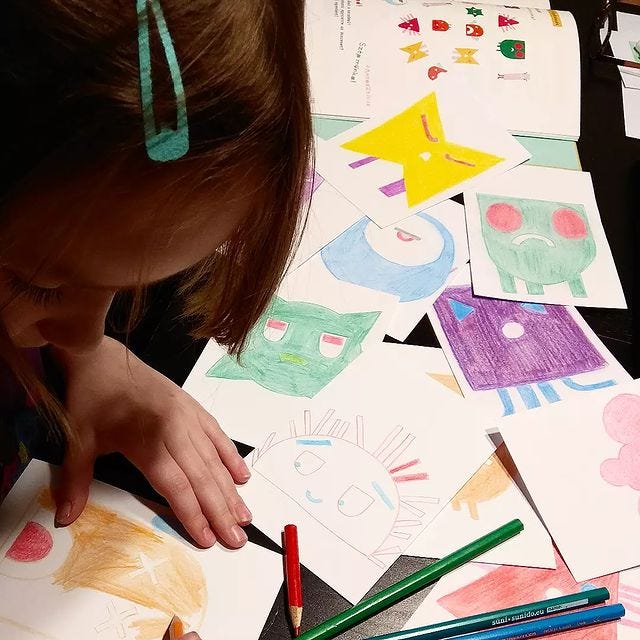No. 35 — Archaeological algorithms 🏺 Book club 🍄 Mushroom atlas
One is a story, the other a series of statements.
My name is Linda. I write a bi-weekly newsletter about computer science, childhood and culture - and there are 9536 of you listening. If you enjoy this issue, please share it with anyone you think may find it useful.
One of the best things I read last week was a 2003 research article called Bubble sort: an archaeological algorithmic analysis.
“We began this study with the intent to document (and ridicule) the continued popularity of bubble sort, but the algorithmic archaeological investigation has proven more interesting than casting aspersions.”
The critique is relevant for me, who absolutely teaches bubble-sort as the first sorting algorithm for non-computer scientists. (Why? Probably, like the article suggests, because it has a cute name, it’s easy to grasp and joyful to execute, even with candies..)
But what I actually like most about the article the methodology. Here is finally a story about a popular algorithm, its history, people who allegedly were involved in creating it, its rise to popularity. And only then comes the performance.
More articles like this, please!
For learning, I think this kind of approach means moving from understanding technology as a mechanical solution to a problem, to a more nuanced progression of choices, people and places. One is a story, the other a series of statements.
Harvard has this course called Classics of Computer Science (COMPSCI 191). In it, the students read a number of computer science papers as “a way for them to see the field as a whole, not through a survey, but by reliving the experience of its creation.”
The professor, Harry R. Lewis, edited last year a book about the papers called Ideas That Created the Future. Classic Papers of Computer Science. I’ve been slowly reading it through, but I find my attention waning. After talking through the Turing piece with a helpful friend, I realised:
I don’t have to do this alone.
So, join me maybe?
I’m imagining something warm, casual and possibly very tiny (might be just me!). Probably audio only, a to make it less stressful. I can lead the discussion, but have neither a background in CS nor math, and I imagine for many engineers this will be too slow. So, think of it like a study group, support community and space to wonder, not a teaching session.
When: Tuesdays 5:00 pm - 6:30 pm GMT, a voice only Discord server.
What: Every week we'll take 3-4 papers from the book and read through them, then share our finds with each other. It’s a dense book, but the papers are not very long
How: I'll create a Google Docs document for us to all post notes and links to what we discover. Between meetings, I'll leave the Google Docs up so we can keep adding new findings throughout the week. The class syllabus is much better in its thematic structure, but I figured I would try to read linearly and put together a draft schedule.
If you’re interested, drop me a note to this e-mail!
(For the book, here is my Bookshop link, but it’s also available as Kindle and in other places. My physical copy is back in Helsinki, hence the picture from last winter. And yes, that’s Linus. It’s a whole other story. )
Linked List
In computer science, a linked list is a linear collection of data elements whose order is not given by their physical placement in memory. But here it is a selection of things I’ve been reading lately.
Papers We Love (PWL) is a community built around reading, discussing and learning more about academic computer science papers. When I finish my own little experiment, I might have the courage to join a chapter!
Hand and Machine research group is hosting an Experimental Clay Residency. I think there are readers who might consider applying - the applications are open until Feb 18th!
Mushroom color atlas. Filter the colors by mushroom type, color, pigment, dye type or fabric. Exactly what Internet was made for.
Classroom
I’m hoping to surface and share stories from all of you and I’d love to see your creations! Here are a few teachers using Ruby in creative, fun and inspiring ways:





I don’t know why seeing the drawings of Internet by children always makes me stop and think.
This decypher-the-message exercise from the first Ruby books has been such a crowdpleaser, had I known, I would have picked more simple drawings to make.
These bug drawings are so good - I like how much space they take! A nice activity to go with these drawings is to come up with three things that are either true or false and practice Boolean logic while at it. Statements can use AND, OR and NOT and could look like this:
I’m red and yellow.
I’m pink or green.
I’m not pink.









Wow! A space for reading Ideas that Created the Future sounds grand. Although I am a web developer I have no Math or CS background either. I would only be able to join from 5-6pm GMT on Tuesday’s because of another study group, but I would be interested in giving it a go! :)
I’ll buy the book and look into it a bit before jumping into commitments, for once! The history of the Computer Age is fascinating, but this sounds like jumping in at the deep end for an amateur CS student like me. Perhaps I might join in as a fly on the wall (… fly in the soup?).